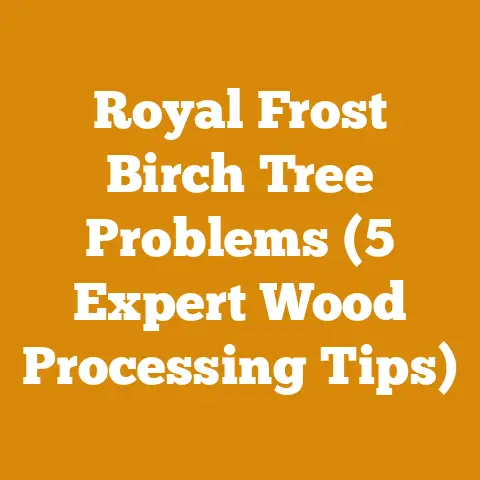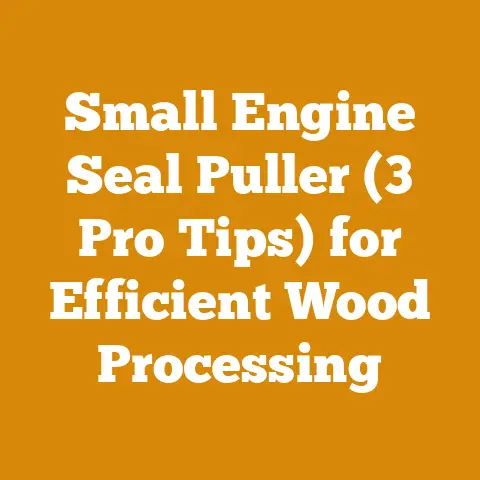What Are the Best Residential Wood Chippers (5 Pro Tips)
Let’s talk wood chippers.
The Best Residential Wood Chippers: 5 Pro Tips
The market’s flooded with wood chippers, and finding the best one for your residential needs can feel like navigating a dense forest. Durability, power, and price all factor in, but first, let’s bust a common myth: bigger is always better. It’s not. A massive, industrial-grade chipper is overkill for most homeowners and can be a pain to store and maneuver. Instead, the ideal residential wood chipper balances power with practicality.
I’ve spent years processing wood, from clearing storm damage to prepping firewood for winter. I’ve seen firsthand what works and what doesn’t. I’ve wrestled with underpowered machines that choke on green wood, and I’ve witnessed neighbors struggle to maneuver behemoth chippers around their yards. That’s why I’ve compiled these five pro tips to help you make an informed decision.
1. Understanding Your Chipping Needs
Before even thinking about brands or horsepower, you need to understand your chipping needs. This is the foundation upon which you’ll build your selection process.
-
Typical Branch Diameter: Are you primarily dealing with small branches (under 2 inches), or are you tackling larger limbs (up to 4 inches or even more)? This is crucial. A chipper rated for 3-inch branches will struggle, and likely break down faster, if you consistently feed it 3-inch material.
- My Experience: I once tried to push a 3.5-inch oak branch through a chipper rated for 3 inches. The machine strained, vibrated violently, and eventually stalled. It took me an hour to clear the jam, and I likely shortened the chipper’s lifespan. Lesson learned: respect the manufacturer’s specifications!
-
Wood Type: Are you chipping mostly softwoods (pine, fir) or hardwoods (oak, maple)? Hardwoods are denser and require more power to chip. Green wood (freshly cut) is also harder to chip than seasoned (dried) wood.
-
Key Concept: Green Wood vs. Seasoned Wood: Green wood has a high moisture content, making it heavier and more fibrous. Seasoned wood has been allowed to dry, making it lighter and more brittle. Seasoned wood chips more easily, but green wood can be chipped for composting purposes.
- Frequency of Use: Will you be using the chipper a few times a year after major pruning, or will it be a regular part of your yard maintenance routine? Occasional use warrants a lighter-duty, less expensive model. Frequent use calls for a more robust and durable machine.
- Mobility and Storage: Do you need to move the chipper around your yard, or will it stay in one place? Consider the weight and size of the machine, as well as whether it has wheels and a tow bar. Also, think about where you will store it when it’s not in use. Limited storage space might rule out larger models.
-
Desired Chip Size: Are you primarily using the chips for mulch, composting, or something else? Different applications require different chip sizes. Some chippers produce finer chips than others.
-
Data Point: Mulch typically benefits from a coarser chip size (1-3 inches) to provide better ground cover and weed suppression. Compost benefits from finer chips (less than 1 inch) to decompose more quickly.
-
Power Source: Do you prefer electric or gas-powered chippers? Electric chippers are quieter and require less maintenance, but they are typically less powerful and limited by the length of the extension cord. Gas-powered chippers are more powerful and portable, but they are louder and require more maintenance.
-
Example: I use an electric chipper for small branches and leaves near my house because it’s quiet and convenient. However, when I’m clearing larger branches further away from the house, I use a gas-powered chipper for its greater power and portability.
Actionable Steps:
- Take Inventory: Walk around your yard and assess the types and sizes of branches you typically need to chip.
- Estimate Usage: How often do you anticipate using the chipper?
- Measure Storage Space: Determine how much space you have available for storing the chipper.
- Consider Power Preferences: Weigh the pros and cons of electric vs. gas-powered chippers based on your needs and preferences.
2. Evaluating Chipper Types and Features
Once you have a clear understanding of your needs, you can start evaluating different types of wood chippers and their features. Residential wood chippers generally fall into a few main categories:
-
Electric Chipper/Shredders: These are typically the least expensive and most lightweight option. They are best suited for small branches (up to 1.5 inches) and leaves. They use rotating blades to chip and shred the material.
- Pros: Quiet, lightweight, easy to use, low maintenance, environmentally friendly.
- Cons: Less powerful, limited to small branches, require an electrical outlet.
-
Gas-Powered Chipper/Shredders: These are more powerful than electric models and can handle larger branches (up to 3 inches). They also use rotating blades to chip and shred the material.
-
Pros: More powerful, portable, can handle larger branches.
- Cons: Louder, require more maintenance, produce emissions, heavier.
-
Chipper Shredder Vacuums: These combine a chipper/shredder with a vacuum function, allowing you to easily collect leaves and debris. They are typically gas-powered.
-
Pros: Versatile, can be used for both chipping and leaf collection.
- Cons: Can be bulky and expensive, vacuum function may not be necessary for all users.
-
Drum Chipper: These are more powerful and efficient than blade-based chippers. They use a rotating drum with knives to chip the material. They are typically gas-powered and can handle larger branches (up to 4 inches or more).
-
Pros: More powerful, efficient, can handle larger branches, produce more uniform chips.
- Cons: More expensive, heavier, require more maintenance.
Key Features to Consider:
- Engine/Motor Power: Measured in horsepower (HP) for gas engines and amps for electric motors. Higher power generally means the chipper can handle larger branches and tougher materials.
- Chipping Capacity: The maximum diameter of branches the chipper can handle. As mentioned earlier, it’s crucial to choose a chipper with a chipping capacity that meets your needs.
- Blade/Knife Material: Look for blades made from hardened steel for durability and longevity. Some chippers have reversible blades, which can be flipped over to extend their lifespan.
- Hopper Size and Design: The hopper is the opening where you feed branches into the chipper. A larger hopper makes it easier to feed branches, especially those with irregular shapes. The design of the hopper should also be considered. Some hoppers are angled to make feeding easier, while others have safety features to prevent hands from getting too close to the blades.
- Safety Features: Look for features like safety interlocks that prevent the chipper from starting if the hopper is not properly secured, and push sticks to help feed branches into the chipper without getting your hands too close to the blades. Emergency shut-off switches are also important.
- Weight and Portability: Consider the weight of the chipper and whether it has wheels and a tow bar. If you need to move the chipper around your yard frequently, a lighter model with large wheels will be easier to maneuver.
- Collection Bag/System: Some chippers come with a collection bag or system to catch the chips. This can be convenient for collecting the chips for mulch or composting.
- Warranty: A good warranty can protect you from unexpected repairs or defects.
Tool Specification Example:
- Gas-Powered Chipper/Shredder:
- Engine: 208cc Gas Engine
- Horsepower: 7 HP
- Chipping Capacity: 3 inches
- Blade Material: Hardened Steel
- Hopper Size: 12 x 15 inches
- Weight: 150 lbs
- Wheels: 10-inch pneumatic tires
- Warranty: 2-year limited warranty
Actionable Steps:
- Research Different Models: Read reviews and compare specifications of different chipper models within your budget.
- Visit a Local Dealer: If possible, visit a local dealer to see the chippers in person and ask questions.
- Assess Key Features: Evaluate the key features listed above based on your specific needs.
- Consider the Warranty: Read the warranty carefully to understand what is covered and for how long.
3. Understanding the Mechanics of Chipping
Knowing how a wood chipper actually works will help you choose the right one and operate it safely and efficiently. The core of any chipper is its cutting mechanism, which typically falls into one of two categories: blades or drums.
-
Blade-Based Chippers: These chippers use one or more rotating blades to chop the wood into chips. The blades are typically mounted on a spinning disc or flywheel. As the wood is fed into the chipper, the blades slice off small pieces, creating the chips.
- Mechanism: The blades operate much like a lawnmower blade, slicing through the wood at high speed. The size and shape of the chips are determined by the angle and sharpness of the blades, as well as the speed of the rotating disc.
- Wood Type Suitability: Blade-based chippers are best suited for small to medium-sized branches and softer woods. They can struggle with larger, tougher branches, especially hardwoods.
- Maintenance: The blades need to be sharpened or replaced regularly to maintain optimal performance. Dull blades will cause the chipper to strain and produce uneven chips.
-
Drum Chippers: These chippers use a rotating drum with knives mounted on its surface. As the drum spins, the knives chip away at the wood.
-
Mechanism: The drum rotates at a slower speed than the blades in a blade-based chipper, but the knives are typically larger and more robust. The drum design allows for more efficient chipping of larger branches and tougher materials. The wood is fed into the drum, where the knives shave off chips as the drum rotates.
- Wood Type Suitability: Drum chippers are better suited for larger branches and tougher woods. They can handle hardwoods and green wood more easily than blade-based chippers.
- Maintenance: The knives on a drum chipper also need to be sharpened or replaced regularly, but they typically last longer than the blades on a blade-based chipper.
Feed Mechanism:
The way the wood is fed into the chipper also plays a crucial role in its performance. There are two main types of feed mechanisms:
-
Gravity Feed: These chippers rely on gravity to pull the wood into the cutting mechanism. You simply drop the branches into the hopper, and gravity does the rest.
- Pros: Simple, inexpensive.
- Cons: Can be slow and require more manual effort, less control over the feed rate.
-
Self-Feed: These chippers have a powered feed mechanism that automatically pulls the wood into the cutting mechanism. This can be a hydraulic or mechanical system.
-
Pros: Faster, more efficient, less manual effort, better control over the feed rate, safer.
- Cons: More expensive, more complex.
Original Insight: The angle of the feed chute matters. A steeper angle allows gravity to assist more effectively, while a wider chute accommodates branches with more irregular shapes.
Understanding Terminology:
- Rotor: The rotating component that holds the blades or knives.
- Anvil: A stationary piece of metal that the blades or knives cut against. The gap between the blade/knife and the anvil is crucial for efficient chipping.
- Impeller: A fan that helps to discharge the chips from the chipper.
Actionable Steps:
- Visualize the Process: Watch videos of different chipper types in action to see how they work.
- Understand the Terminology: Familiarize yourself with the key terms and components of a wood chipper.
- Consider the Feed Mechanism: Decide whether a gravity feed or self-feed chipper is better suited for your needs.
- Research Maintenance Requirements: Understand the maintenance requirements for different chipper types, including blade/knife sharpening or replacement.
4. Prioritizing Safety: A Non-Negotiable
Wood chippers are powerful machines that can cause serious injury if not operated safely. Safety should be your top priority when using a wood chipper.
-
Personal Protective Equipment (PPE): Always wear appropriate PPE, including:
- Eye Protection: Safety glasses or goggles to protect your eyes from flying debris.
- Hearing Protection: Earplugs or earmuffs to protect your ears from the loud noise of the chipper.
- Gloves: Heavy-duty work gloves to protect your hands from cuts and scrapes.
- Long Sleeves and Pants: To protect your skin from flying debris.
- Steel-Toed Boots: To protect your feet from falling branches and other hazards.
- Read the Owner’s Manual: Before using the chipper, read the owner’s manual carefully and understand all of the safety instructions.
- Clear the Work Area: Make sure the work area is clear of obstacles, such as rocks, roots, and debris. Keep children and pets away from the work area.
- Inspect the Chipper: Before each use, inspect the chipper for any damage or worn parts. Make sure all guards and safety devices are in place and functioning properly.
- Start the Chipper Safely: Follow the manufacturer’s instructions for starting the chipper. Make sure the chipper is on a stable, level surface.
- Feed the Chipper Properly: Use a push stick to feed branches into the chipper. Never use your hands to push branches into the chipper. Avoid feeding branches that are too large or have knots.
- Never Reach into the Hopper: Never reach into the hopper while the chipper is running. If a branch gets stuck, turn off the chipper and wait for the blades to stop completely before attempting to remove the branch.
- Be Aware of Kickback: Kickback can occur when a branch is suddenly ejected from the chipper. Be prepared for kickback and keep a firm grip on the branch.
- Never Leave the Chipper Unattended: Never leave the chipper unattended while it is running.
- Turn Off the Chipper Before Servicing: Always turn off the chipper and disconnect the spark plug (for gas-powered models) or unplug the chipper (for electric models) before performing any maintenance or repairs.
- Store the Chipper Safely: When not in use, store the chipper in a safe, dry place.
Case Study: Near Miss
I witnessed a neighbor using a wood chipper without eye protection. A small piece of wood flew out of the hopper and struck him in the face, narrowly missing his eye. He was lucky to escape with only a minor scratch. This incident highlighted the importance of wearing appropriate PPE at all times.
Emergency Procedures:
- Know the location of the nearest first aid kit.
- Know how to shut off the chipper quickly in an emergency.
- Have a plan for contacting emergency services if needed.
Safety Interlocks:
- Understand how the safety interlocks on your chipper work. These devices prevent the chipper from starting if the hopper is not properly secured or if other safety conditions are not met. Never bypass or disable these safety devices.
Actionable Steps:
- Complete a Safety Training Course: Consider taking a safety training course on wood chipper operation.
- Create a Safety Checklist: Develop a safety checklist to follow before each use of the chipper.
- Practice Emergency Procedures: Practice emergency shut-off procedures so you can react quickly in an emergency.
- Enforce Safety Rules: Enforce strict safety rules for anyone operating or working near the chipper.
5. Budget and Long-Term Costs
The initial purchase price of a wood chipper is only one part of the equation. You also need to consider the long-term costs of ownership, including maintenance, repairs, and fuel (for gas-powered models).
- Initial Purchase Price: Wood chippers range in price from a few hundred dollars for small electric models to several thousand dollars for larger gas-powered models. Set a budget based on your needs and financial situation.
-
Maintenance Costs: All wood chippers require regular maintenance, such as blade/knife sharpening or replacement, oil changes (for gas-powered models), and air filter cleaning. Factor these costs into your budget.
- Data Point: Blade sharpening can cost $10-$20 per blade, while blade replacement can cost $30-$50 per blade. Oil changes for gas-powered chippers typically cost $20-$30.
- Repair Costs: Unexpected repairs can be costly. Consider purchasing a chipper with a good warranty to protect you from unexpected expenses.
- Fuel Costs: If you choose a gas-powered chipper, factor in the cost of fuel. The amount of fuel you use will depend on the size of the engine and the amount of time you use the chipper.
- Storage Costs: If you don’t have a garage or shed, you may need to rent storage space for your chipper.
- Depreciation: Like any piece of equipment, a wood chipper will depreciate over time. This means that its value will decrease. Consider the depreciation when deciding whether to buy a new or used chipper.
Strategic Advantage: Consider renting a wood chipper instead of buying one if you only need it a few times a year. This can save you money on initial purchase price, maintenance, and storage.
Cost-Benefit Analysis:
Before making a purchase, perform a cost-benefit analysis to determine whether buying a wood chipper is the right decision for you. Consider the following factors:
- The cost of buying and maintaining a wood chipper.
- The cost of hiring a professional to chip your branches.
- The value of the wood chips you will produce.
- The convenience of having a wood chipper on hand.
Example:
Let’s say you typically spend $200 per year to have a professional chip your branches. A wood chipper costs $1000 and has annual maintenance costs of $100. In this case, it would take you 5 years to break even on the cost of buying the wood chipper. However, if you value the convenience of having a wood chipper on hand, it may be worth the investment even if it takes longer to break even.
Actionable Steps:
- Create a Budget: Set a budget for your wood chipper purchase.
- Research Long-Term Costs: Research the long-term costs of ownership, including maintenance, repairs, and fuel.
- Consider Renting: Consider renting a wood chipper instead of buying one if you only need it a few times a year.
- Perform a Cost-Benefit Analysis: Perform a cost-benefit analysis to determine whether buying a wood chipper is the right decision for you.
By carefully considering these five pro tips, you can choose the best residential wood chipper for your needs and budget, while prioritizing safety and long-term value. Remember to always prioritize safety, and happy chipping!






